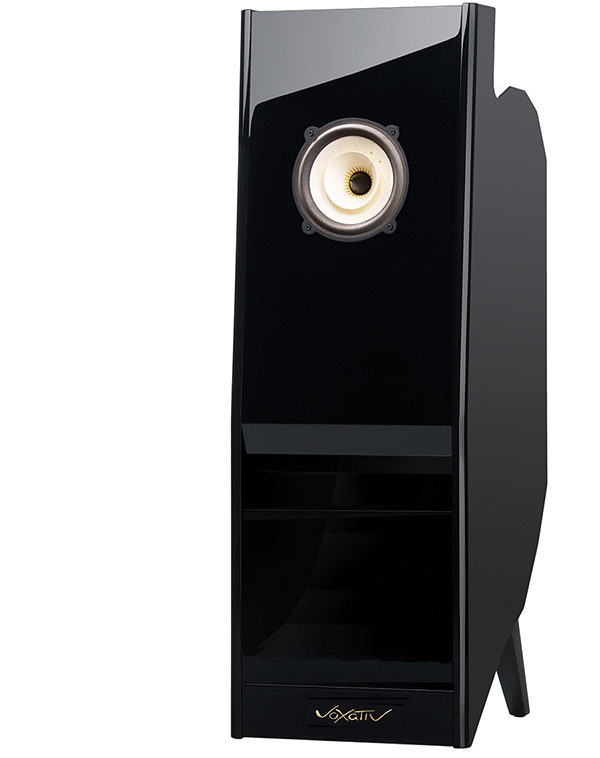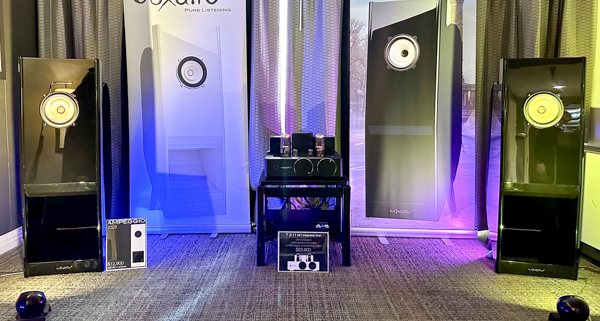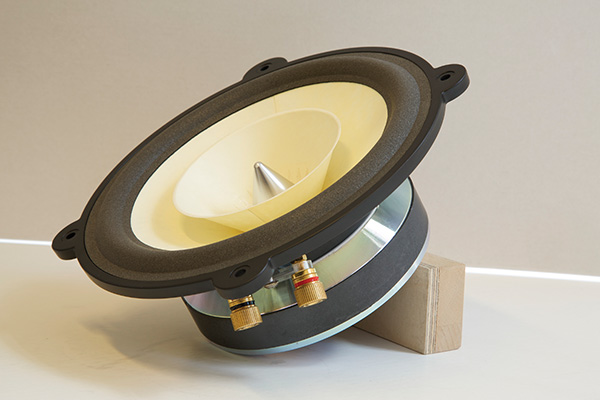| Columns Retired Columns & Blogs |
Brilliance is gender-blind.

"I've now encountered a single-driver dynamic speaker I could live with," Art concluded. "In most audio reviews that's faint praise, but in this one it's a revelation."
I quote Art's review not only as an homage to the man (who has now been gone four years) and the unrivaled clarity, flow, and humor of his writing but as an introduction to a loudspeaker he would surely be reviewing if he were still with us.
Launched in 2008 by Voxativ's Inès Adler, the Voxativ Ampeggio has now been resurrected as the Ampeggio 2024, with an optimized cabinet, a redesigned support system, and a choice of 8" full-range drivers (the original driver was 7"). In 2011, at the time of Art's review, a pair of Ampeggios cost $29,750. Today, the base-model Ampeggio 2024 with the paper-cone AC-1.9 driver costs $13,900/pair.
The Ampeggio 2024
Adler's resumé is impressive. An engineer veteran of Mercedes-Benz, she holds 23 patents. Her studies in mechanical and electrical engineering and thermodynamics prepared her for her role with the team that developed the first fully electrical diesel injection system.
I first encountered the Ampeggio 2024 in 2023, at that year's Capital Audiofest (below), powered by Voxativ's 12Wpc, single-ended T211 integrated amplifier. I reported that the Ampeggio 2024s streaming Jacques Loussier playing his unique, jazzified Bach "breathed, tossing out music well beyond physical boundaries. The presentation had punch, precision, and presence in spades. ... The Voxativs played big and generous of soul and disappeared, regardless of genre."

Every Voxativ loudspeaker is assembled by hand in Voxativ's Berlin factory, by Adler and her three-person team. In addition to 14 single-driver speaker models, the company makes and sells 16 full-range drivers for DIY projects (footnote 1). Why full-range?
"A full-range driver provides the perfect point source, and without a crossover," Adler said. "Capacitors and coils"—inductors—"work like little batteries; they keep part of the music, better to leave them out. With my experience of now 40 years in speaker and driver construction, I'm still learning and optimizing."

Voxativ's full-range driver is available with many variations. For the Ampeggio 2024, Voxativ offers a choice of two drivers, the AC-1.9, which, when chosen, results in a total speaker price of $13,900/pair, and the AC-4B, which raises the price of the Ampeggio 2024 almost to the level of the original Ampeggio: $26,900/pair. The AC-1.9 is made of a smooth, heavy paper known as Simili Japon. The AC-4B is available in wood or the same paper, but wood is recommended; on both drivers, the whizzer, which extends the highs, is made from Simili Japon paper. The cone is set in a diecast-aluminum frame with a surround constructed of a "special foam" made in Germany that's said to last 10 years. "It's absolutely resistant to humidity and the things that make surround foams break in other designs," Adler said. "We've used it for 15 years with no problems."
Like its 2011 predecessor, the Ampeggio 2024 is a back-loaded horn speaker, which means that its full-range driver fires forward into open space while the cabinet it fires from serves as an extended horn for the backwave.
What are the challenges in creating such a loudspeaker? "You need a lot of experience to implement a full-range driver in a housing," Adler responded over email. "Because Qts and behavior between driver and housing must match. This is the biggest challenge in the construction."
For those of you who aren't speaker builders, Qts, or "total Q," is the "quality factor" of a loudspeaker driver, a measure of how well damped it is or how poorly, factoring in both electrical and mechanical damping. Higher Qts equals less damping.
Qts is a primary determinant of the suitability of a driver for use in a particular loudspeaker design. A rule of thumb says that a driver with a Qts between 0.4 and 0.7 is most suitable for a sealed-box design, for example, but it depends on the specific enclosure, and exceptions are common.

What makes the two available drivers different from each other? Damping factors, sensitivity, and magnet material. The cheaper AC-1.9 driver has a ferrite magnet, a Qts of 0.66, and a sensitivity of 91dB at 60Hz and 97dB at 5kHz. The more expensive AC-4B driver uses a neodymium magnet and has a Qts of 0.40—lower Q means better damping—and is significantly more sensitive: 96dB at 60Hz and 100dB at 5kHz. In addition to aiding resolution, Adler says, the wooden cone on the AC-4B "smooths the mids and highs," but at the expense of some low end.
"The best overall choice is the AC-1.9," Adler suggested. "It can do female voices as well as metal music. The 4B series is the better choice for resolution enthusiasts. It's the most well-tuned version. Higher-level drivers have more resolution in the highs, but the bass reproduction is lower. A Voxativ Bass Module is recommended when using the Ampeggio with the 4B driver."
Both Ampeggio drivers have a phase plug made of aluminum or brass or, for an additional $295, oiled and polished birch, maple, or oak. Regardless of the material choice, the phase plug "guides the high frequency waves out of the driver center," Adler wrote.
"The phase plugs help guide the coloration of the higher frequencies," Adler added. Output from the AC-1.9 driver is "a little lower in the high frequencies. You can push it by using an aluminum or brass plug; the brass is a little prettier. Both are cut on CNC machines. If you have an amplifier where the coloration is more peaky, then you use a wooden plug. Customers can order what they like." In terms of sonics, "metal is a bit more clear and cold," Adler said. "Wood sounds smoother." My review pair came with paper-cone AC-1.9s and wooden phase plugs.
As a single-driver speaker, the Ampeggio is, of course, crossover-free. It is connected to custom-made, pure copper binding posts via a short run of a Voxativ-made wire consisting of "eight strings of solid-core pure copper and a small string of silver, and the shield," Adler told me over Skype.
The new 8" drivers required a new, matching horn. The walls of the Ampeggio's twice-folded horn cabinets are built by a small Polish piano company of 22mm MDF; the cabinets of the original Ampeggio were built in the German Schimmel piano factory, out of tonewood from Schimmel's collection. The new 2m-long horn is 8% longer than the original, the mouth 12% bigger with optimized folding and a back chamber that's a little bit larger. That big mouth vents toward the listener at the bottom of the cabinet.


I use some AC X-4 drivers in an open baffle horn and love them.

"Voxativ Ampeggio may be your speaker—maybe the last one you ever buy."
When I was in my teens, my first half decent speaker was a pair with Plessey Rola 8" Twincones.
They do say you "go back to your roots" in your mind just before the end is nigh.
Cheers George

This is cool if all you listen to is string quartets, but otherwise I just can’t fathom paying this much money for a speaker this large and imposing, yet still be in dire need of a subwoofer.

It's cool if you can, but my ears have needs they simply cannot meet.
Conceptually though, I get it - no crossover or phase interactions with other drivers. Unfortunately, physics says no to actual full range.

There’s room for so many different tastes!

People who try to tell me what I like, or that I'm wrong for my subjective experience is beyond annoying. Ugh, they're exhausting.
The ASR trolls are the worst; like they come here and troll then go back and gloat about it. How pathetic of a person does someone have to be to derive joy from that? They also turn on their own, which is funny in a schadenfreud sense: "I didn't think the face eating tiger would eat my face!"

"You're right. I've only red the measurements page from John Atkinson. As I do for any review from Stereophile."

...you've done a great job there of owning the ASR followers. I don't know if that site is going to be able to recover from your acidic comment.
And I love your subjective spelling. Showing results for schadenfreude
Search instead for schadenfreud

touched a nerve did I? Glad you were able to recognize yourself in my comment. You're a variation on Ortofan (who confusingly never talks about Ortofon carts).
Oh, and sorry I went with the way it's typyically pronounced in America with only 3 syllables when I spelled it. If you know German you know what I mean, if not who cares.

NEEDS to correct your poor German. lol.

The answer lies in your use of ‘followers.’

I guess the old saying is right about squeaky wheels and grease. Thank you.


John Atkinson's "measured performance 'doesn't look impressive'" may be an understatement. Bass has a -5 dB dip @ 75 Hz then it falls off a cliff. How/why did the already big 10k Hz peak get worse in the upgrade 13 years later? (That peak is now + 10 dB from 7500-15k then a cliff.) A 5 dB peak @ 2100 Hz.
Is everyone who strictly requires notes audible below D2 (73.42 Hz) suffering from a personality defect? On a string bass normal tuning, D2 is the 3rd open string from the top. On a piano D2 is the white key between the 2nd pair of black keys from the L. D2 is one tone below a 6-string guitar's low E (E2,) it's lowest tone in normal tuning (vertically the highest string and the thickest string.) When a 6-string guitar is tuned to "open D" the lowest open string is D2.
And finally, JA's quote: "...measurements may well look worse than they sound." Is the opposite impossible, that it sounds even worse than the measurements?
Has any other component testing so badly received similar apology?

These are a niche product, either it's your thing or it isn't. As noted above, not my thing. As noted by others, it is their thing. Freedom!

I expect effective bass with boundary reinforcement to somewhere in the 50s (hopefully low 50s) and relatively smooth response (no worse than a decent 2-way) to well, whatever...even if starts a smooth HF roll off around 9k I'd prefer that over this dumpster fire.
Instead though, what I would do if I was married to the idea of a 1-way speaker is to start with a distributed bass array which can be tuned properly to as high as about 125 Hz. Then I'd design the 1-way to cover about 125-9k Hz and add a reverberant field system to fill in the missing treble.
It's wrong to ignore Doppler distortion with 1-way speakers. 100 Hz = 11.25 foot wavelength frequency-modulating the treble where 9k Hz = .125 feet. Anyone who thinks such distortion is not hugely audible may be hugely mistaken. Connect a tweeter to a baffle and frequency modulate the baffle @ 100 Hz. Who thinks that's not audible? Surely, a port or horn-loading can diminish the cone movement but only over a limited range. What's that cone's distortion like fed a 30 Hz high output tone, not uncommon with electronica?
Did Adler get hearing damage while working toward patents for automotive engines? I presume the author mentioned the patents to impress readers. I instead conclude to avoid automotive science as a precursor to loudspeaker design. Maybe Adler should have inverted the career timeline, starting first with luxury audio then shifting to automotive patents where hearing is irrelevant or almost.
@ SWAF I heard the Pure Audio Project speaker with Voxativ mid-range. Adler and the PAP designer openly laughed simultaneously at any and every use of beryllium for loudspeaker design. Glass houses.

...that mostly doesn't understand what you're talking about.
Or else they can't see it, because they're blinded by that beautiful but very expensive piano black finish.
Wilson and Tekton could both learn something from studying that great paint job, which doesn't constantly remind everyoe who looks at it of a Chevy.

... as supamark stated, these are a niche product, not to be the speaker for everyone and all genres. Their respective designers recognize this. If one listens exclusively metal, rap or hardcore techno, these may not be the appropriate speakers for that task. You said you heard the Pure Audio Project speakers at SWAF - how did they sound to you? I heard both speakers and I thought they sounded fantastic considering the rooms the hotel had on offer. I asked Inès to play some "doof-doof" (what some Germans call techno) and she played cued up some electronica and you know what? It sounded great! Did the room shake and shudder? No... but again, that is not the focus of these designs.
If my listening preferences leaned towards the lighter fair where midrange is the focus (acoustic recordings, vocals, etc.) I would seriously consider the Ampeggio, but they aren't, so these are not the speakers for me. I can still appreciate them, though.

and you have this web page to rant.
Who is playing electronica with these speakers? Hmm? And it appears that one can if they want- see the comment above.
Your comments are misogynistic and insulting. I think you are rather jealous of her career and find this web page to rant.

Thanks, Ken.
And thank you for the Art Dudley quotes on the musical quality of some gear to "simply nail notes" and allow a listener to "subconsciously bask in it", in tuneful pitch and pitch-relations. Throw in a healthy dose of PRaT*, and, as I... feel it, you've got something really special: A highly musical communicator.
*Or PRaD as Colloms almost dubbed it**. Similarly, I've read somewhere that the P in PRaT originally denoted Pitch (and not (rhythmic) Pace). A tiny acronym can only encompass so much complex musicality, and PRaT is probably best left alone. Pitch quality, however, in its various organizations, is up there with rhythmic elements as pillars of musical meaning in music playback, to me.
**https://www.stereophile.com/reference/23/index.html